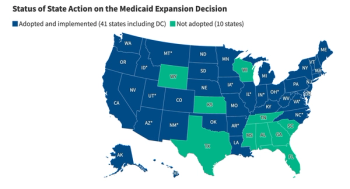
Survey reveals EDI claims volume
A new released by the Cooperative Exchange (CE) sheds new light on claims transactions, revealing just how big a footprint EDI has
Electronic data interchange (EDI) continues to make the healthcare industry more efficient.
Besides living up to HIPAA by streamlining claims processing and payment safely, EDI lays the groundwork for efficiency and tomorrow's clinical data exchanges, all while reducing paper.
Past studies demonstrate the efficacy of EDI. A 2006 America's Health Insurance Plans (AHIP) report found electronic submission of health insurance claims had more than tripled in the last decade, reducing administrative costs, and allowing 98% of claims to be processed within 30 days of receipt. The percentage of claims received electronically was 75% in 2006, up from 44% in 2002.
A new study last year released by the Cooperative Exchange (CE), the leading association for the healthcare transaction clearinghouse, sheds new light on claims transactions, revealing just how big a footprint EDI has.
CE's executive director collected, assessed, and compiled data from eight study participants who shared aggregate 2007 claims data for this survey. The report details specific trend data on electronic claims submission, including the number of claims sent electronically, how many submitting provider organizations are using electronic claims, and the dollar amount those transactions represent.
Methodology:
Totals were submitted for unique claims submitted by medical professional claims (837p) and by institutions (837i). Duplicate claims, such as claims that traversed multiple clearinghouses before arriving at a payer were excluded. Initial claims to a secondary payer were counted, as they represent a distinct transaction. Totals were submitted for the number of submitting (billing) providers offices versus individual providers. Members who accepted transactions directly from a PMIS (patient management information system) or other primary source included these claims as well. Finally, members reported the total dollar value of fees submitted on unique claims; the fee values of secondary claims were excluded.
Results:
In all, the eight clearinghouses submitted more than 400 million unique claims from more than 100,000 providers representing more than half a trillion dollars. The average fee submitted per claims was $174.30 for a professional claim and $3,740.02 for an institutional claim. (The study excluded dental claims.)
Total dollar value for 837 (p) was $50 billion and $472 billion for 837 (i).
And while impressive, the number of claim transactions reported only represents health industry claims and does not report on the additional transaction sets that include eligibility, remittances, treatment authorization and claim status.
The CE survey supports:
This survey documents the growing use and greater acceptance of EDI across both institutions and individual providers. Within the individual provider category, there remains significant room for growth with regard to EDI transactions. Among existing EDI users, there is an expectation of continued growth in the type of transactions supported by individual clearinghouses.
Tim McMullen is the executive director of Cooperative Exchange
Charlotte Martin is the president and CEO of Gateway EDI
Douglas J. Bilbrey is executive vice president of sales and marketing for the SSI Group, Inc.
Newsletter
Get the latest industry news, event updates, and more from Managed healthcare Executive.






















































